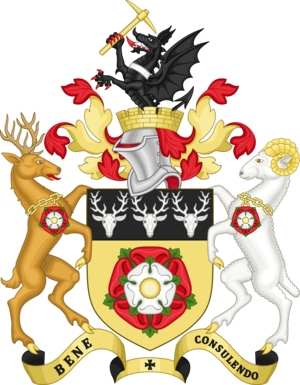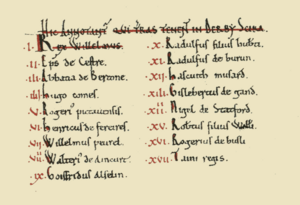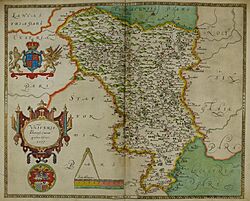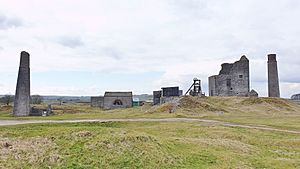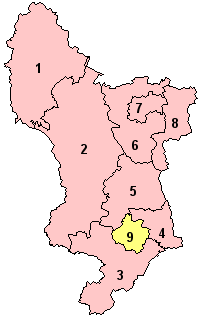History of Derbyshire facts for kids
The history of Derbyshire goes back a very long time. People have lived here since the last Ice Age, over 10,000 years ago! The county of Derbyshire in England has been around since the 11th century.
Contents
How Derbyshire Began
Derbyshire is first mentioned in an old book called the Anglo-Saxon Chronicle in the year 1048. It talks about an earthquake and a big fire in Derbyshire. This shows that the name "Derbyshire" was already being used back then.
Some old records might seem to mention Derbyshire even earlier, but they usually just name places like Hope or Ashford. The name Derbyshire comes from the Old English word shire. A shire was a part of a kingdom with its own leader. The town of Derby was the main centre for this area.
Nature's Story in Derbyshire
The White Peak area of Derbyshire is famous for its limestone landscape. This rock formed about 300 million years ago! This area is usually between 200 and 300 metres above sea level.
Around the White Peak, you'll find the Dark Peak. This area has younger rocks like sandstones and shales. These rocks form a horseshoe shape around the limestone.
Ancient Times: Prehistory
Scientists have found signs of early humans in places like Creswell Crags. They found ancient rock art, stone axes, and bones from animals like hyenas and woolly rhinoceroses. This shows people lived here a very long time ago!
Derbyshire has many ancient stone circles and monuments. Arbor Low is the biggest stone circle in the county. Other cool sites include Doll Tor and Nine Ladies. These were built by people in the Neolithic (New Stone Age) and Bronze Age.
Archaeologists also found remains of Stone Age homes at Lismore Fields in Buxton. These included a roundhouse made of timber and two longhouses.
During the Iron Age, people built hillforts. These were strongholds on hills, like at Mam Tor and Castle Naze. Most of these ancient sites are now protected as Scheduled Monuments.
Roman Derbyshire
Before the Roman conquest of Britain in the 1st century AD, the Coretani tribe lived in Derbyshire. Later, the area became part of the Roman province called Flavia Cæsariensis.
The Romans were in Britain from the 1st to the 5th centuries. They built military forts, roads, and started mining for lead in Derbyshire. Some Roman forts were at Derventio (near Derby), Chesterfield, and Navio. Each fort usually had a small town, called a vicus, nearby.
Buxton was a Roman bath town called Aquae Arnemetiae. It was built around the natural warm springs. Lutudarum was the Roman centre for lead mining near Wirksworth.
The Romans also built important roads. Ryknield Street connected Derby to other parts of England. Batham Gate led to Buxton, the bath town.
Saxon Times
In Anglo-Saxon times, Derbyshire was part of the kingdom of Mercia. Saxon kings even had a home by the River Trent at Repton. Two Mercian kings are buried there.
During the reigns of King Æthelred and King Alfred, there were many battles between the Saxons and the Danes (Vikings) in Derbyshire. The Vikings even took over the town of Derby for many years.
Near Repton, there's a Viking cemetery called Heath Wood. It has 59 burial mounds. This is the only known Scandinavian cremation site in the British Isles.
Norman Conquest and Beyond
After the Norman Conquest in 1066, a big survey called the Domesday Book was made in 1086. It listed all the main landowners in Derbyscire. These included King William the Conqueror himself, and important people like Henry de Ferrers and William Peverel. William Peverel built the famous Peveril Castle at Castleton.
For a long time, Derbyshire was divided into areas called Hundreds. These were based on even older divisions. The Royal Forest of Peak was a huge royal hunting area in the north-west of Derbyshire. It was managed by William Peverel.
Elizabethan Era
During the time of Queen Elizabeth I, several grand houses were built in Derbyshire. These included Chatsworth House and Hardwick Hall.
Mary Queen of Scots was held captive by George Talbot, 6th Earl of Shrewsbury at Chatsworth House for many years. She was allowed to visit the spa town of Buxton to use the warm springs for her rheumatism.
Stuart Period
During the English Civil War (1642–1646), Derbyshire mostly supported the Parliamentarians (the "Roundheads"). Sir John Gell helped protect Derby against the Royalists (the "Cavaliers").
A famous event happened in the village of Eyam during the Great Plague of 1665–1666. The villagers bravely chose to isolate themselves to stop the disease from spreading to other towns.
The Industrial Revolution
The Industrial Revolution changed Derbyshire a lot. In the early 18th century, Richard Arkwright set up cotton-spinning mills. He used new machines by the River Derwent at Cromford.
These mills, like Cromford Mill and Derby Silk Mill, helped create the factory system we know today. The Derwent Valley Mills area is now a UNESCO World Heritage Site. This means it's a very important historical place for the whole world.
Mining for limestone and lead was also very important. Lead had been mined since Roman times. New machines helped increase production. Magpie Mine near Bakewell is a good example of these old lead mines.
Derby became a major centre for engineering and railways in the 19th century.
Georgian and Victorian Eras
Buxton and Matlock Bath became popular spa towns in the 18th century. The Dukes of Devonshire helped build grand places like the Buxton Crescent to make Buxton as famous as other spa towns like Bath.
When railways arrived in the 19th century, even more visitors came to the Peak District towns from places like London and Manchester.
Derbyshire in the 20th Century
Derbyshire County Council was set up in 1889. Today, the county is divided into 8 main areas:
- Amber Valley Borough Council
- Erewash Borough Council
- Bolsover District Council
- Chesterfield Borough Council
- North East Derbyshire District Council
- High Peak Borough Council
- Derbyshire Dales District Council
- South Derbyshire District Council
Derby City Council became a separate local authority in 1997. However, Derby is still part of the ceremonial county of Derbyshire.
See also


